

Development tools and Software / nRF52832 / Bluetooth low energy / Products / Home - Ultra Low Power Wireless Solutions from NORDIC SEMICONDUCTOR. The nRF52832 SoC is supported by the nRF52 DK development kit.
Software support for the nRF52832 SoC is split in two major parts: SoftDevices, which are complete wireless protocol stacks; and the nRF5 Software Development Kit (SDK) forming a common code base for the nRF52832 SoC. nRF52 DK The nRF52 DK are versatile single board development kits for Bluetooth® Smart, ANT and 2.4GHz proprietary applications using the nRF52832 SoC. The kits supports development for the nRF52832 SoC.
The kits are hardware compatible with the Arduino Uno Revision 3 standard, making it possible to use 3rd-party shields that are compatible to this standard. The kits supports the standard Nordic Software Development Tool-chain using Keil, IAR and GCC. A number of 3rd party companies have made both complementary components as well as HW solutions based on nRF52 Series devices. Integrated Filters 3rd Party Matching Filters 3rd Party Modules Software The nRF52 SoC is supported by an extensive offering of Software. Developing a Generic Hard Fault handler for ARM Cortex-M3/Cortex-M4 - Sticky BitsSticky Bits.
ConvertKeilCCS. Video links for Real-Time Bluetooth Networks. Real-Time Bluetooth Networks - Shape The World Jonathan Valvano and Ramesh Yerraballi This material is being developed for an online class that is running September 2016 to December 2016 on the edX platform.

Tutorial: Create a Hello ARM test project. Note: This page was superseded by the new Create a Blinky ARM test project page.
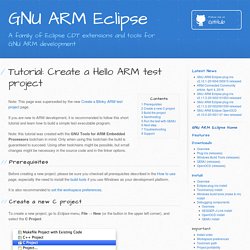
If you are new to ARM development, it is recommended to follow this short tutorial and learn how to build a simple test executable program. Note: this tutorial was created with the GNU Tools for ARM Embedded Processors toolchain in mind. Only when using this toolchain the build is guaranteed to succeed. Using other toolchains might be possible, but small changes might be necessary in the source code and in the linker options. YAGARTO - Yet another GNU ARM toolchain. Elsevier · Martin, T: The Designer’s Guide to the Cortex-M Processor Family · Welcome. Cortex-M Learning Platform. The CMSIS workshop provides step-by-step instructions to create and debug embedded applications.
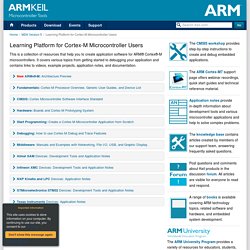
The ARM Cortex-M7 support page offers webinar recordings, quick start guides and technical reference material. Application notes provide in-depth information about development tools and various microcontroller applications and help to solve complex problems. The knowledge base contains articles created by members of our support team, answering frequently asked questions. Post questions and comments about Keil products in the discussion forum. All articles are visible for everyone to read and respond. µVision User's Guide: Peripheral Variables. ARM Connected Community. ARM Connected Community. Use case of MSP and PSP in Cortex M. Having two separate stack pointers allows the operating system to be safer and more robust.

Usually, you would configure the operating system toy use Main Stack Pointer (MSP) and user applications to use Process Stack Pointer (PSP). The switch from one stack to another then happens automatically when an exception is handled. The fact that the operating system and exception handlers use a different stack from the application means that the OS can protect its stack and prevent applications from accessing or corrupting it. You can also ensure that the OS does not run out of stack if the application consumes all the available PSP stack space - that means that there is always space on the stack to run an exception handler in the case of an error occurring.
Note that you don't have to use both stack pointers. Hope this helps. C - How do I execute a function from RAM on a Cortex-M3 (STM32)? Tutorials on ARM Cortex-M Series - An Overview. MDK-ARM Version 4.74 Evaluation Software Request. QRC0001 UAL. ARM University Program. We may collect and store information about your visit to our web site automatically using browser cookies (files which are sent by us to your computer) or similar devices which we can access when you visit our web site in future.
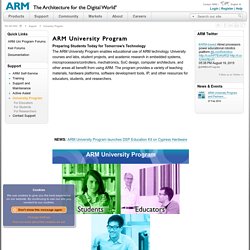
Please read our Cookie Policy to find out more about the cookies we use. You can control the cookies set by this website by using the slider below, and by saving your settings. These settings only apply to the ARM Website you are currently visiting and any changes you make will not apply to any other ARM websites. We cannot turn off cookies which fall under the strictly necessary category, as these are essential in order to enable you to move around the website and use its features.
Please read our Cookie Policy to find out how to control these using your browser settings. ARMv7 M ARM. DDI0337H cortex m3 r2p0 trm. IHI0042E aapcs. QRC0001 UAL. M3%20Guide. JoeTheProfessor. 01: ARM Cortex-M Instruction Set Architecture. MaJerle/stm32f429. Arm_inst.pdf. Introduction to the ARM. An Introduction to the ARM System Architecture What is an ARM processor and why haven't I heard about it?

ARM - an acronym for: Advanced RISC Machines The processor originated in England in 1984. At its inception ARM stood for Acorn RISC Machine. The first ARM reliant systems include the Acorn: BBC Micro, Masters, and the Archimedes. During this early period they were used mostly for British educational systems, and therefore, were not widely available or known outside England. What is a RISC machine anyways? It is worthwhile to go over this concept since RISC is implied in the name! So, what make the ARM architecture so special? Look at the list of currently available processors and their architectures. As you ask yourself, "What does that all really mean?
" Small die size translates into low cost since much of the cost of a chip is proportional to the die area. Having small die area and simple pipeline construction allows the other major benefit of the ARM chip. What should I use to develop on STM32 ? Processor Expert Software, Microcontroller Dr. Microcontroller Driver Suite v10.4 is a software management system that generates C code to create, configure, optimize, migrate and deliver software components, such as peripheral drivers, for Kinetis and ColdFire+ processors.
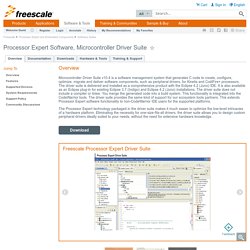
The driver suite is delivered and installed as a comprehensive product with the Eclipse 4.2 (Juno) IDE. It is also available as an Eclipse plug-in for existing Eclipse 3.7 (Indigo) and Eclipse 4.2 (Juno) installations. The driver suite does not include a compiler or linker. Tutorial: IAR + FreeRTOS + Freedom Board. Maybe Eclipse is ‘too much’, and you are looking for something different?

The cool thing with Processor Expert is that while this is Eclipse based, you can use it easily with other tool chains like IAR Embedded Workbench. Building Super Small Linux Computers From Scratch. Conventional wisdom says small, powerful embedded Linux like the Raspberry Pi, Beaglebone, or the Intel Edison are inherently manufactured devices, and certainly not something the homebrew tinkerer can produce at home.
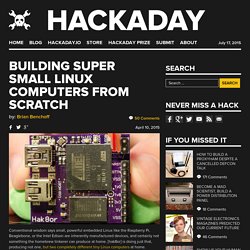
[hak8or] is doing just that, producing not one, but two completely different tiny Linux computers at home. The first is based on Atmel’s AT91SAM9N12 ARM processor, but the entire board is just about two inches square. On board is 64 MB of DDR2 DRAM, a USB host and OTG port, and not much else. Still, this chip runs a stripped down Linux off of a USB drive. The second board is based on the Freescale i.MX233. The real value of [hak8or]’s project is the incredible amount of resources he’s put into his readme.mds for these repos. CMSIS Workshop. ARM Architecture & Programming Tutorial. Efficient Software Development with ARM CMSIS v4. Cortex_debug_connectors.pdf. Microcontrollers. Print password request form: Before we can grant you access to our confidential documents you are required to fill in, print and sign the password request form by which you comply with the NXP Non-disclosure agreement (NDA). Please email or fax the signed form to the email-address or fax-number specified on the form.
After approval you will receive username and password via email. ULINKpro User's Guide: ARM Standard JTAG. WX STM32F3DISCOVERY with STM32F303 MCU [STM32F3DISCOVERY] - $21.00 : The Way Of Engineer, online shopping for IC,Development Kit,Connector,Connector,Module. STM32F3DISCOVERY, Discovery kit for STM32 F3 series - with STM32F303 MCU Description The STM32F3DISCOVERY helps you to discover the STM32 F3 series Cortex-M4 mixed-signals features and to develop your applications easily.
It includes everything required for beginners and experienced users to get started quickly. ST Microelectronics. CD00167594. Performance and basic connectivity. Print password request form: Before we can grant you access to our confidential documents you are required to fill in, print and sign the password request form by which you comply with the NXP Non-disclosure agreement (NDA). Please email or fax the signed form to the email-address or fax-number specified on the form.
After approval you will receive username and password via email. - Tag Connect. LPCOpen Software Development Platform. LPCOpen v2.xx is initially available for a limited number of devices and platforms, but will be quickly ramped up with additioanl devices and boards. To quickly get started with LPCopen v2.xx, check out the LPCOpen v2.xx quickstart guides.
Select one of the device families below to go to the LPCOpen platform download pages for that family. If your desired device isn't available in the package download list below, you'll need to use the legacy v1.03 release in the legacy download sections further down this page until the v2.xx package is ready. LPCOpen v2.xx for LPC8xx family devices LPCOpen v2.xx for LPC11xx family devices LPCOpen v2.xx for LPC13xx family devices. STM32-H103. Starter files for embedded systems. Example files associated with the three books. Benjamin's robotics. What is an ARM Accredited MCU Engineer? LED Blinking ~ ARM7. Program for LED blinking: /* connect PORT0 P0.16 – P0.15 to LEDs*/ ARM Download Files. ARM Cortex Tutorials. Electronics Circuits Support: Start Learning ARM processor - First Project LED blinking - Circuit and Programming - Software and Simulation.
LCD Interfacing (Displaying count from 0 to 200) ~ ARM7. /*LCD Count value display */ /*Connections from LPC2148 to LCD Module: P0.0 to P0.7 used as Data bits. P1.16 connected to pin4 i.e. PulkoMandy's home on the web. So I just got this STM32F3 Discovery board. ARM based. ARMv7 Cortex M3 and Cortex M4 examples and source-code. Simulation software ProteuS application in ARM system design « Dave Ross Blog. Getting started with Freescale's Freedom KL46Z Development Board - Microcontroller - eewiki. ARM microcontrollers. Development ARM Boards. ARM Accredited MCU Engineer (AAME) Accreditation. TI ARM. The coming age of ARM chips for the hobbyist.
Blueboard-lpc214x - BlueBoard-lpc214x is a low cost ARM development board. AllAboutEE/ARM-Programming-Examples-TM4C. SMD Adapters. Default. Learning Microcontrollers - NXP, MICROCHIP and more. DM00039084.pdf. STM32-H103-sch.gif (GIF Image, 1512 × 1041 pixels) - Scaled (67%) SAM D Microcontrollers - Microcontroller - eewiki. Questions about LPCXpresso, keil uvision MDK AR... LPC2106 ARM7DTMI GLCD-KS0108 DCF77 DS18S20. ET-ARM Stamp.
Texis Instrument TM4F129 ARM Coretex M4F. NXP LPC1114. NXP LPC1343. New LPC Microcontroller Streamlines Motor Control. NXP LPC810. AN11071: In-Application Programming for the LPC1700. STM32F103. STM32F411. STM32F429. nRF52832.